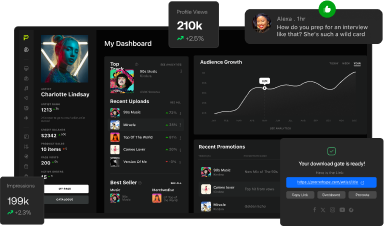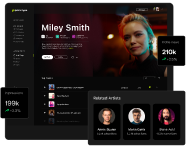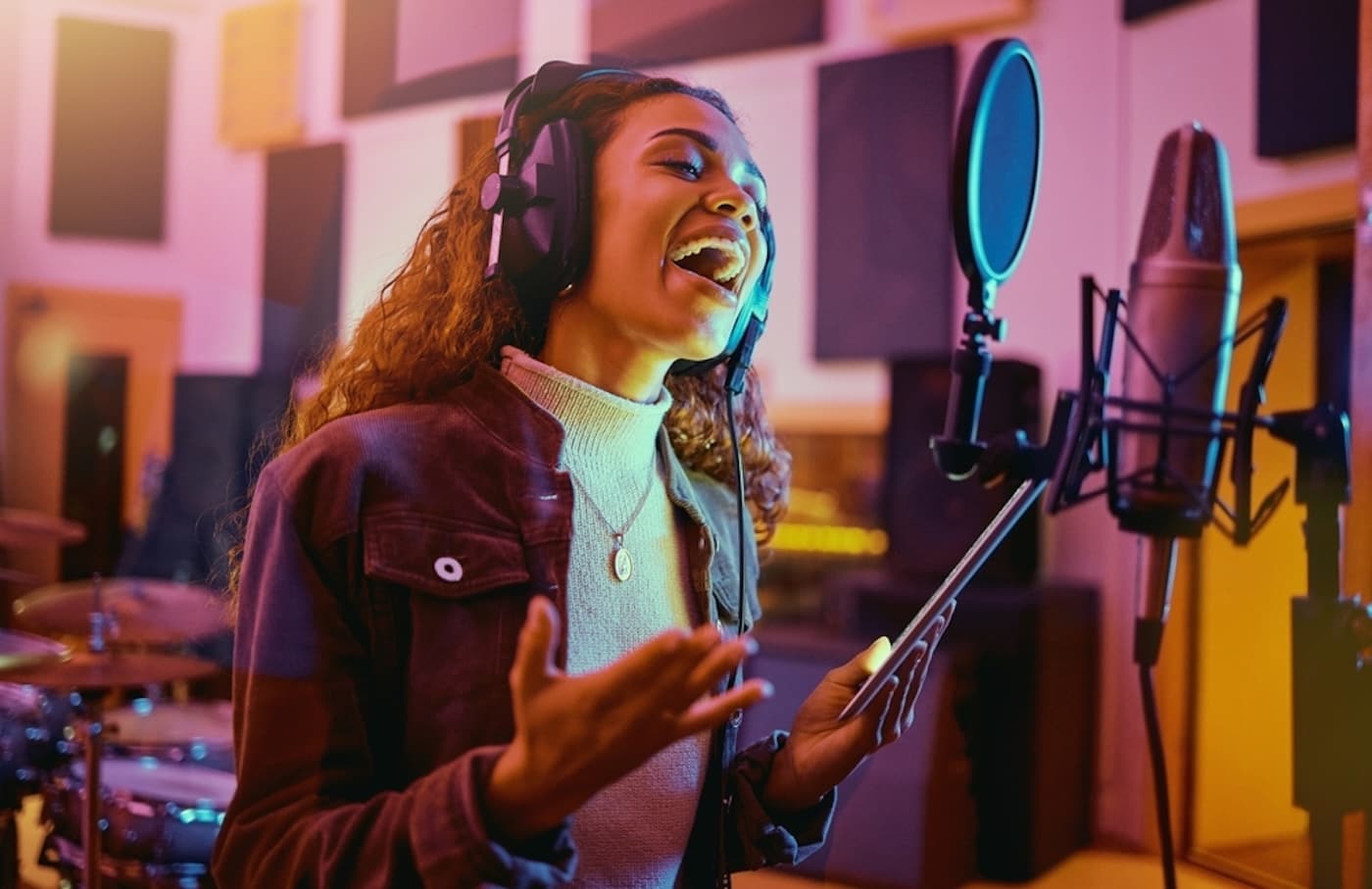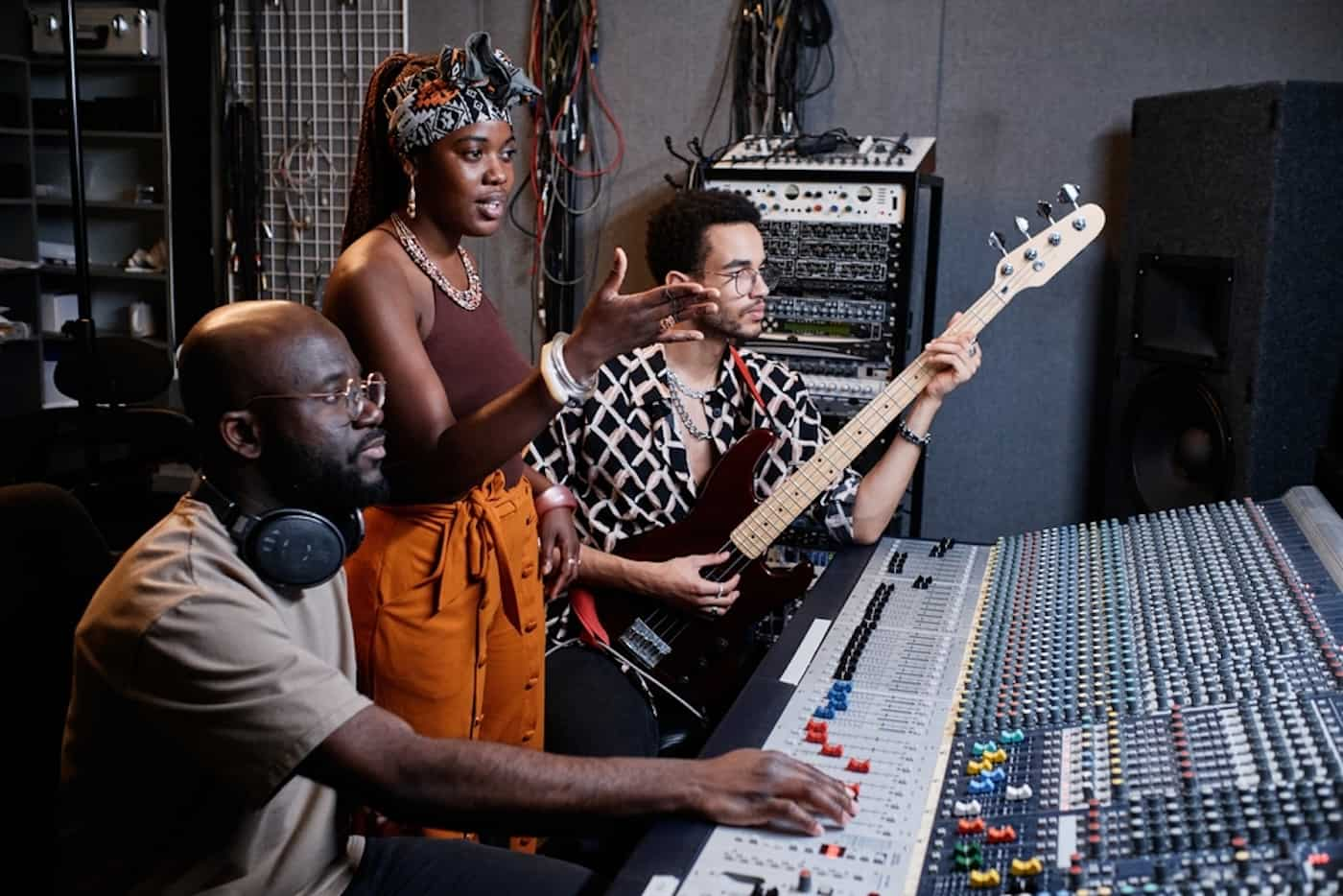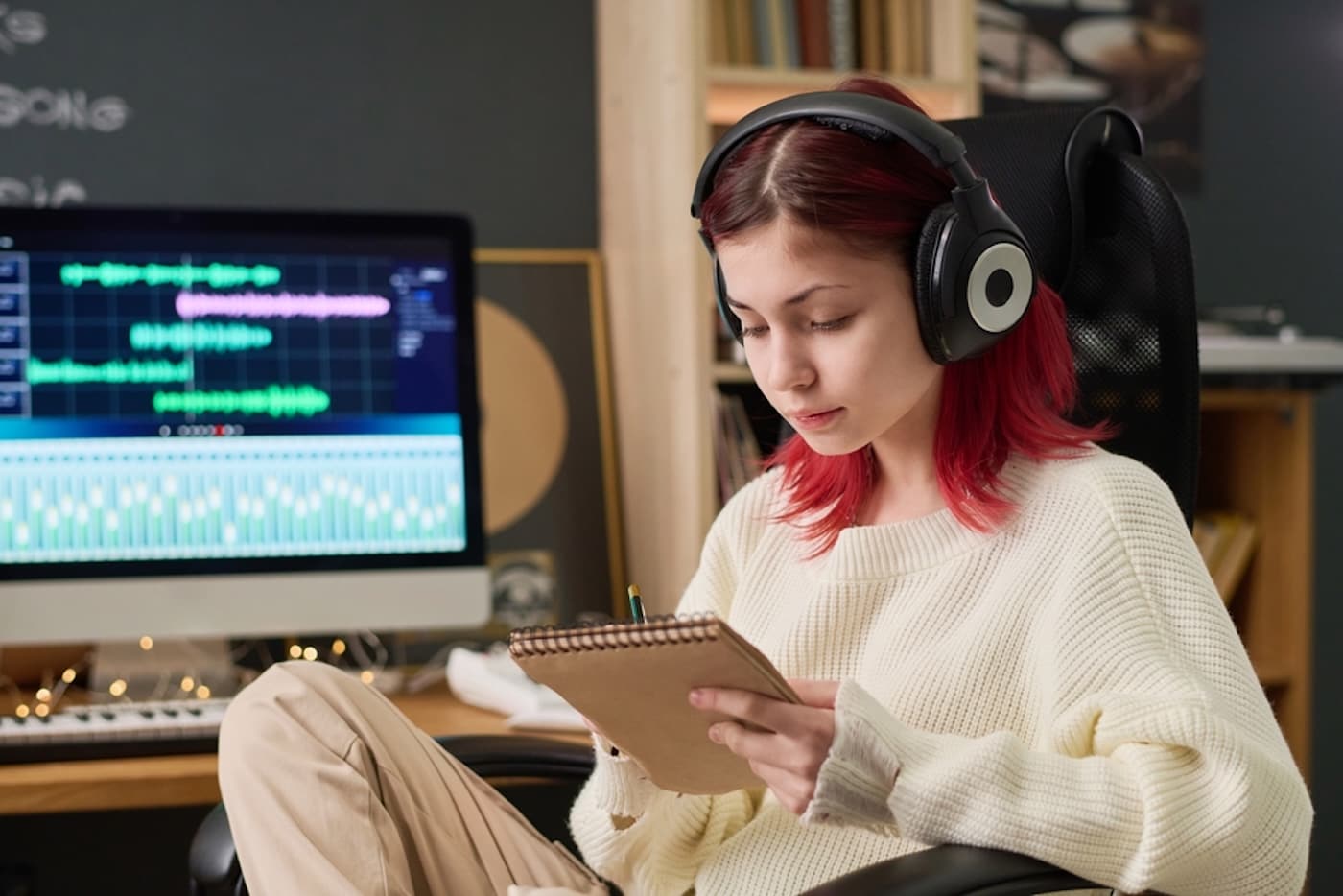
Music royalties generated by copyrighted music are one of the primary forms of payment for musicians and producers today.
Revenue from royalties can come from multiple sources, with variable rates, payment terms, and conditions based on licensing agreements.
This guide demystifies the concept of music royalties to help recording artists maximize their earnings across all platforms.
Get Early Access
To Promo Hype
What Are Music Royalties?
Music royalties are payments made to rights holders based on the performance, airtime, and other forms of reproduction.
Rights holders include original songwriters, composers, and recording artists, with royalties providing compensation for making music.
Music royalties are also an excellent way to make money as a music producer, providing an ongoing revenue stream for released tracks.
There are several types of music royalties used in the music industry, each with different requirements and circumstances to consider.
How Do Music Royalties Work?
Music royalties work by generating revenue based on how a song is used, with payments issued to the relevant copyright holders.
Whenever someone wishes to use a song, such as a venue owner, a license is required for the song composition and sound recording.
Music royalties are then generated based on licensing terms, with revenue then distributed to the rightful owners.
This process varies based on the types of music royalties being collected, which we’ll cover in detail throughout this guide.
Why Are Music Royalties Important?
Music royalties serve a range of functions in the music industry, ensuring fair compensation for artists and sustaining their careers.
Here are some other reasons why music royalties offer value to musicians and composers:
- Transparency with publishers: Music publishers are expected to provide complete transparency and clarify their approach to royalty calculation. Understanding how it works enables artists to ask the right questions and secure the best rates for their work.
- Providing legal protection: By taking a stringent approach to copyright, artists can gain peace of mind knowing their work is legally protected. This ensures exclusive rights to the copyright holder along with complete control over how it is used.
- Driving the creative process: By generating a consistent stream of income through royalties, artists become incentivized to continue the creative process. This income gives them the freedom to explore other popular music genres and collaborate with other artists.
- Diversifying income: Music royalties fit into a broader network of potential revenue for artists by monetizing streaming, radio plays, and other uses in media. This income can be combined with live performances, merchandise sales, and other revenue streams.
If you’re becoming a music producer, understanding how royalties operate will enhance your ability to monetize your work.
Types Of Music Royalties Explained
With several types of music royalties available, understanding how they’re distinguished from one another is essential for artists.
Let’s break down the different types of music royalties in detail, and how you can combine them to generate additional revenue:
Public Performance Royalties
As the name suggests, performance royalties are generated when a song is performed in a commercial environment.
This is focused on conventional public broadcasters, but can also incorporate music royalties generated through streaming services.
From the conventional perspective, public performance royalties occur from use on radio and TV shows, as well as in clubs, bars, and restaurants.
This type of revenue is often collected and distributed through performance rights organizations (PROs), from which broadcasters receive the license.
Data based on this use is then used to accurately distribute the blanket license money to the relevant songwriters and copyright owners.
If you’re considering submitting music to radio stations, registering with a PRO ensures the correct collection and distribution of royalties.
Digital Performance Royalties
While the standard public performance royalties relate to play time on traditional radio stations, digital performance royalties differ.
If your music is performed on webcasting platforms that stream musical compositions, such as SiriusXM and Pandora, royalties are generated.
It’s important to note that the rule in the USA surrounding non-payment to sound recording owners for radio airplay doesn’t apply here.
If the music is played on digital internet radio, cable radio, or satellite radio stations, the master owners are reimbursed.
Digital radio stations must acquire a statutory license from SoundExchange, permitting them to use licensed music.
Likewise, recording artists, record labels, and session musicians need to register with this organization to collect digital performance royalties.
Under the law, these royalties generated are distributed in the following manner:
- Featured artists: 45%
- Rights owners: 50%
- Non-featured artists: 5%
These rates are set by the U.S. Copyright Royalties Board, which also provides support for performing artists surrounding publishing royalties.
Mechanical Royalties
A long-standing approach to revenue for artists is mechanical royalties, which occur based on physical or digital reproduction of music.
Understanding the difference between mechanical royalties and performance royalties allows artists to capitalize on multiple income streams.
Mechanical royalties generated from CD and vinyl record sales, and expanded with revenue from digital downloads.
They also overlap with streaming royalties, with mechanical royalties generated whenever songs are played on Spotify, Apple Music, and streamed on demand.
Streaming Royalties
While plays on streaming services generate both mechanical royalties and streaming royalties, there are distinctions between the two.
Both are initiated through interactive streaming performances, but with different payout structures that artists should be aware of.
Streaming royalties are typically paid to the owner of the sound recording and copyright holder, often the record label or publishing company.
On the other hand, independent artists frequently use music distribution services to manage their uploads and collect royalties.
In this sense, the management of streaming royalties depends on the status of a given songwriter or artist and the associated terms.
With streaming services like Spotify paying out vast sums of money, it’s one of the most commonly used sources of royalty payments.
Neighboring Rights & Royalties
Neighboring rights royalties are closely related to public performance royalties, with the distinction based on the types of copyrighted music.
While public performance royalties are paid to copyright holders who own musical compositions, neighboring rights royalties go to other parties.
These include the copyright holders of the sound recording, performing artists, and, depending on the arrangement, record labels.
Like performance royalties, PROs are often used to collect royalties from their respective markets and distribute them accordingly.
This collection and distribution can also be impacted by local legislation, which can vary in terms of who is entitled to compensation.
For example, American terrestrial radio doesn’t compensate sound recording owners, but in other countries, this rule doesn’t apply.
Learn more: The best music production equipment for beginners.
Synchronization Royalties
Synchronization royalties, sometimes called “sync licenses” or “sync license fees,” relate to payments for the use of music in visual media.
This covers everything from the use of copyrighted music in advertisements, TV shows, video games, movies, and other media.
There are many instances in which music has been used to generate synchronization royalties by established singers and bands.
The use of Kate Bush’s “Running Up That Hill” in the Netflix series Stranger Things and “Lust for Life” by Iggy Pop in Trainspotting are two examples.
Earning synchronization royalties can be challenging for up-and-coming artists, but landing a deal can provide significant exposure.
The Australian band Jet rose to prominence after “Are You Gonna Be My Girl” was used on Apple’s iPod commercial in the early 2000s.
Emerging artists can improve their odds by seeking out partnerships with licensing companies or networking with music supervisors.
Print Royalties
Print royalties are the least common of all the types of music royalties and are paid whenever sheet music is sold.
While many bands and singers don’t release sheet music of their work, some earn money publishing these documents.
They provide valuable resources for other music users to learn about composition, whether small-scale compositions or full-ensemble works.
The payments for print music royalties are typically split between the publishing company and songwriters whenever sheet music is sold.
Get Early Access
To Promo Hype
The Role Of Trademarks In Music Royalties
Trademarks play a vital role in how the music industry manages the royalties generated by artists and safeguards their creative efforts.
While copyright is necessary for protecting the musical work, trademark applies to a range of other processes in the music industry.
Putting these measures in place is essential for protecting your work, and taking measures should another party violate your trademark.
Here are some other important reasons why you should include trademarking along with copyright protection:
- Legally codifying your brand: Learning how to trademark a band name ensures your name and branding elements, such as logos, are protected in the event of plagiarism.
- Selling branded merchandise: With a trademark secured, artists and bands can use their visual assets freely on T-shirts, mugs, and other merchandise for increased revenue.
- Earning money with brand collabs: Artists often combine their own brand with others through collaborations, such as the Beats by Dre headphone range.
- Third-party licensing: Once a trademark has been established, it can be licensed to third parties and commercial ventures for additional income.
By registering your artist trademark, you can gain peace of mind knowing you have legal ownership of your name and other assets.
Royalties & Copyrighted Music
Understanding the types of copyrighted music is crucial for recognizing how it can be leveraged to generate income through royalties.
Here’s a brief overview of the two primary types of copyrighted music that can impact how royalties are generated and collected.
Songwriting Copyright
The first primary type of copyrighted music is songwriting copyright, also referred to as the musical composition copyright.
This copyright refers to the individual who has written a song, covering the underlying work that other artists can record, sample, and arrange.
As such, songwriting copyright covers everything from the authored notes and lyrics to the music’s melodies, types of chords, and harmonies.
While registration isn’t mandatory, some artists register their work with the relevant office, such as the U.S. Copyright Office.
This ensures additional legal advantages should the artist find themselves in court challenging infringements of their work.
Once copyright protection has been secured, it lasts for the entire lifetime of the artist, who retains complete ownership.
Sound Recording Copyright
The sound recording copyright is distinct from songwriting and composition copyrights, in that it applies to a specific recorded version.
If you’re an independent artist with a home recording studio, you can copyright any recordings you’ve personally funded.
In addition to being held by the producer, sound recording copyright is often held by the record label, separate from the composer’s ownership.
This allows music publishers and labels to license their sound recording copyrights for use in films, commercials, and other media.
Sound recording copyright owners also have exclusive rights to:
- Issue and rent the music to the public: This includes digital distribution on streaming and download platforms, or live concerts and other public performances.
- Create derivatives based on the original work: Creating a cover song, remix, or other type of altered version is also an option for copyright holders.
- Perform copyrighted music through various media: Performance through music streaming, radio stations, music videos, and TV is all permissible when copyright is secured.
Additionally, the rights owner can transfer these rights through licensing agreements or assignments with the proper authorization.
Copyright Ownership In The Music Industry
While independent artists approach copyrighted music with specific goals, copyright law has recently been shaking up the music industry.
Here’s an overview of how this process impacts different artists, from independent songwriters to those with a record or publishing deal.
Independent Artists
Independent artists automatically own the copyright to their music once it has been composed and recorded.
This gives them complete control over how it can be used across all media, whether licensing to others or distributing on streaming services.
Many successful independent artists enter into agreements with platforms to generate music, such as using a digital music distributor.
Artists With a Record Deal
Once artists sign up to a record deal, copyright ownership is often passed over to the label along with the master recording.
This allows artists to access further funding for upcoming projects, as well as access to production facilities and marketing services.
While the label controls how the recordings are used, artists receive royalties generated based on the terms of the recording deal.
Many record labels looking for artists offer attractive contracts that help maximize the artist’s reach and increase their royalty income.
Artists With A Publishing Deal
If you’re considering exploring the option of music publishing, the first thing to understand is how copyright ownership is transferred.
As with record deals, publishing deals pass off many of the administration, licensing, and other processes surrounding ownership.
This includes using the publisher’s industry connections to secure lucrative licensing and synchronization royalties.
The publisher also manages administrative tasks surrounding registration with performance rights organizations and other bodies.
While this is the typical approach, it is possible to get a publishing deal that allows artists to retain copyright after a determined period.
Some deals allow artists to retain their songwriting credit, making it critical for independent artists to seek clarification before signing a contract.
Related read: Find out how to get signed to a record label.
How Are Music Royalties Collected?
We’ve explored some methods through which royalties generated are collected, notably through Performance Rights Organizations.
Here are other ways artists can collect royalty payments based on their published music:
- Mechanical Licensing Agents: Organizations such as the Harry Fox Agency and Music Reports are frequently used in the United States to handle mechanical royalties and licensing.
- Record label and publishers: Artists who have partnered with a record label or music publishers typically take a hands-off approach to royalty collection, with their partner managing the process.
- Digital music distribution services: If you’re an independent artist, digital music distribution platforms can manage your music royalties across all featured streaming platforms.
In some instances, sub-publishers may be involved in collecting royalties, with collection agencies also used for various royalty types.
Potential Challenges With Music Royalties
While royalty collection is a long-standing source of income in the music business, there are some challenges to be mindful of.
If you’re new to the concept, here are some potential obstacles to be aware of, and steps you can take to gain clarity:
- Complexity of licensing agreements: Licensing agreements can be complex, incorporating different payment structures, warranties and indemnities, and other factors. This makes it vital to read through the fine print and clarify anything you don’t understand with the other party.
- A lack of reliable/transparent data: Inaccurate metadata can pose issues when collecting royalties, particularly when credits and rights holder information is wrong. Likewise, tracking data across multiple platforms can be challenging, although there are tools you can use to help.
- Theft through AI-generated content: The rise of AI music production tools has led to growing concerns around copyright, intellectual properties, and royalties. AI models trained on music without the artist’s consent are something to be aware of when sharing your work.
- Delayed royalty payments: Royalties generated from music can sometimes take time to process or face restrictions due to minimum revenue thresholds. You should also be mindful of Black Box royalties, which refer to unclaimed royalties generated and can create legal issues.
By understanding these challenges, you can ensure your work is adequately protected to deliver the maximum potential revenue.
Resources For Calculating Royalties
With so many types of royalties to factor in when calculating your income from music, getting an accurate figure can be a challenge.
Fortunately, there are resources you can use to calculate the royalties generated from your released music.
Here are some tools you can use to ensure your royalty payments are accurate:
- Performance Rights Organizations: Several music industry organizations offer tools that provide an estimate of your music royalties. ASCAP and SoundExchange both include resources that weigh a range of metrics to evaluate royalties generated by members.
- Digital music distribution services: If you’re using a digital distribution service for managing uploads, these often include streaming performance data. You can use these platforms to gain a clear overview of royalties generated on Spotify, TIDAL, Apple Music, Amazon Music, and elsewhere.
- Royalty rate databases: Utilizing a music royalties database, such as RoyaltyRange, can provide a deeper understanding of the varying rates offered by different platforms. It can also help you better understand licensing agreements and optimal structures to look for.
You can assess your royalties generated across multiple platforms and use these calculation tools to break down the differences.
Read next: The best DAWs.
Tips For Maximizing Your Music Royalties
Collecting music royalties is a reliable way to earn money, but it can be easy to overlook opportunities to leverage all types.
Follow these steps to maximize your music royalties and ensure your songs are achieving their full potential earnings:
- Register with Performance Rights Organizations: If you’re music is being played in venues or on the radio, registering with a Performance Rights Organization is essential. ASCAP and BMI are two examples of PROs used by artists to collect royalties from these sources.
- Analyze your royalty sources: While many artists upload their music across multiple streaming services, their core audience often congregates on a particular platform. Analyzing which royalty sources are getting the best results will help you determine where to promote your music for maximum attention.
- Seek out sync licenses: Acquiring synchronization royalties requires a proactive approach, involving the submission of work to industry professionals. Build a strong portfolio and provide stems from your music recordings.
- Promote your music online and IRL: A professional website and social media pages are excellent tools for driving traffic to your music. If you’re experienced with live performances, you can get gigs as a musician to further build a fan base.
You can also use tools to gather data and assess your performance on music streaming services across a range of metrics.
Summary
If you’re composing original music or learning how to master sound recording, music royalties are essential for long-term monetization.
By aligning your efforts and diversifying your content, you can draw on multiple sources of music royalties to build your career.
Make sure you research industry-related organizations that can support your efforts and help you resolve disputes if they occur.
Get Early Access
To Promo Hype
Join Promo Hype
